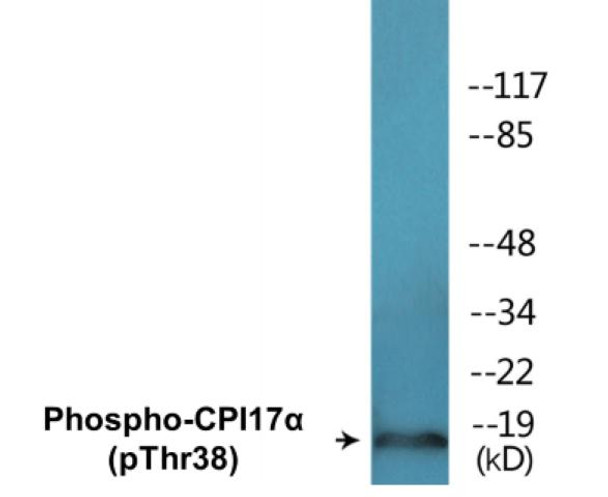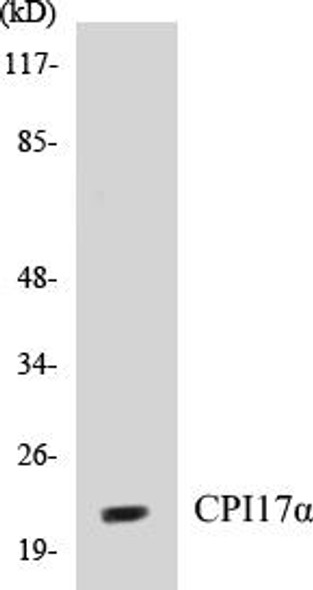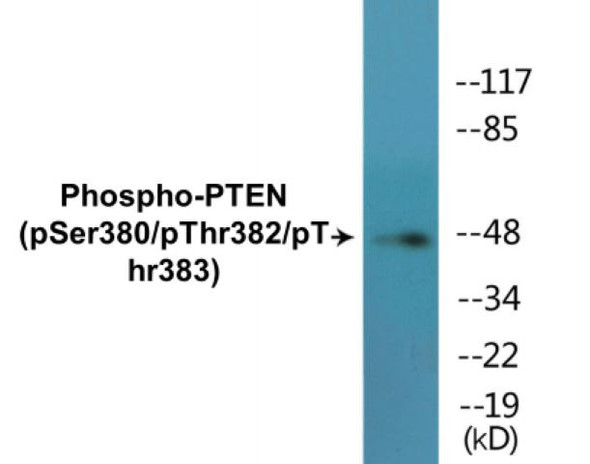CPI17alpha (Phospho-Thr38)Colorimetric Cell-Based ELISA Kit (CBCAB00463)
- SKU:
- CBCAB00463
- Product Type:
- ELISA Kit
- ELISA Type:
- Cell Based Phospho Specific
- Reactivity:
- Human
- Mouse
- Rat
- Detection Method:
- Colorimetric
Description
CPI17alpha (Phospho-Thr38)Colorimetric Cell-Based ELISA Kit
The CPI-17α Phospho-Thr38 Colorimetric Cell-Based ELISA Kit from Assay Genie is a powerful tool for studying the phosphorylation status of CPI-17α in cell-based assays. This kit allows for the accurate and sensitive measurement of CPI-17α phosphorylation at Thr38, providing valuable insights into the regulation of smooth muscle contraction and cell signaling pathways.CPI-17α is a key regulator of smooth muscle contraction and is known to be phosphorylated at Thr38 in response to various stimuli. Dysregulation of CPI-17α phosphorylation has been implicated in a variety of diseases, including cardiovascular disorders and smooth muscle-related pathologies.
By using this kit, researchers can investigate the role of CPI-17α phosphorylation in these conditions and potentially identify new therapeutic targets.With its high sensitivity and specificity, the CPI-17α Phospho-Thr38 Colorimetric Cell-Based ELISA Kit offers reliable and reproducible results, making it an essential tool for any research laboratory studying smooth muscle biology, cell signaling, or cardiovascular disease. Trust Assay Genie for all your ELISA kit needs and unlock new insights into cellular signaling pathways and disease mechanisms.
| Product Name: | CPI17alpha (Phospho-Thr38) Colorimetric Cell-Based ELISA |
| Product Code: | CBCAB00463 |
| ELISA Type: | Cell-Based |
| Target: | CPI17alpha (Phospho-Thr38) |
| Reactivity: | Human, Mouse, Rat |
| Dynamic Range: | > 5000 Cells |
| Detection Method: | Colorimetric 450 nm |
| Format: | 2 x 96-Well Microplates |
The CPI17alpha (Phospho-Thr38) Colorimetric Cell-Based ELISA Kit is a convenient, lysate-free, high throughput and sensitive assay kit that can detect CPI17alpha protein phosphorylation and expression profile in cells. The kit can be used for measuring the relative amounts of phosphorylated CPI17alpha in cultured cells as well as screening for the effects that various treatments, inhibitors (ie. siRNA or chemicals), or activators have on CPI17alpha phosphorylation.
Qualitative determination of CPI17alpha (Phospho-Thr38) concentration is achieved by an indirect ELISA format. In essence, CPI17alpha (Phospho-Thr38) is captured by CPI17alpha (Phospho-Thr38)-specific primary antibodies while the HRP-conjugated secondary antibodies bind the Fc region of the primary antibody. Through this binding, the HRP enzyme conjugated to the secondary antibody can catalyze a colorimetric reaction upon substrate addition. Due to the qualitative nature of the Cell-Based ELISA, multiple normalization methods are needed:
| 1. | A monoclonal antibody specific for human GAPDH is included to serve as an internal positive control in normalizing the target absorbance values. |
| 2. | Following the colorimetric measurement of HRP activity via substrate addition, the Crystal Violet whole-cell staining method may be used to determine cell density. After staining, the results can be analysed by normalizing the absorbance values to cell amounts, by which the plating difference can be adjusted. |
| Database Information: | Gene ID: 94274, UniProt ID: Q96A00, OMIM: 608153, Unigene: Hs.631569 |
| Gene Symbol: | PPP1R14A |
| Sub Type: | Phospho |
| UniProt Protein Function: | PPP1R14A: a phosphorylation-dependent inhibitory subunit of protein phosphatase 1 (PP-1A). Phosphorylation by PKC regulates its binding to PP-1A. Acts co-operatively to inhibit myosin light chain phosphatase (MLCP) activity. Inhibition leads to increased myosin phosphorylation and enhances smooth muscle contraction in the absence of increased intracellular Ca(2 ) concentration. Involved in the regulation of cell morphology, re-organisation of microfilaments, and cell spreading. Also expressed in human platelets and in brain where it may play a role in cerebellar long-term synaptic depression. Phosphorylation by ILK or Rho kinase enhances its ability to inhibit PP-1A. |
| UniProt Protein Details: | Protein type:Inhibitor; Protein phosphatase, regulatory subunit Chromosomal Location of Human Ortholog: 19q13.1 Cellular Component: cytosol Molecular Function:protein phosphatase inhibitor activity Biological Process: negative regulation of catalytic activity; regulation of phosphorylation; small GTPase mediated signal transduction |
| NCBI Summary: | The protein encoded by this gene belongs to the protein phosphatase 1 (PP1) inhibitor family. This protein is an inhibitor of smooth muscle myosin phosphatase, and has higher inhibitory activity when phosphorylated. Inhibition of myosin phosphatase leads to increased myosin phosphorylation and enhanced smooth muscle contraction. Alternatively spliced transcript variants encoding different isoforms have been noted for this gene. [provided by RefSeq, Sep 2011] |
| UniProt Code: | Q96A00 |
| NCBI GenInfo Identifier: | 55583974 |
| NCBI Gene ID: | 94274 |
| NCBI Accession: | Q96A00.1 |
| UniProt Secondary Accession: | Q96A00,Q7Z4X7, Q96S54, |
| UniProt Related Accession: | Q96A00 |
| Molecular Weight: | 13,480 Da |
| NCBI Full Name: | Protein phosphatase 1 regulatory subunit 14A |
| NCBI Synonym Full Names: | protein phosphatase 1 regulatory inhibitor subunit 14A |
| NCBI Official Symbol: | PPP1R14A |
| NCBI Official Synonym Symbols: | CPI17; CPI-17; PPP1INL |
| NCBI Protein Information: | protein phosphatase 1 regulatory subunit 14A |
| UniProt Protein Name: | Protein phosphatase 1 regulatory subunit 14A |
| UniProt Synonym Protein Names: | 17 kDa PKC-potentiated inhibitory protein of PP1; Protein kinase C-potentiated inhibitor protein of 17 kDa; CPI-17 |
| UniProt Gene Name: | PPP1R14A |
| UniProt Entry Name: | PP14A_HUMAN |
| Component | Quantity |
| 96-Well Cell Culture Clear-Bottom Microplate | 2 plates |
| 10X TBS | 24 mL |
| Quenching Buffer | 24 mL |
| Blocking Buffer | 50 mL |
| 15X Wash Buffer | 50 mL |
| Primary Antibody Diluent | 12 mL |
| 100x Anti-Phospho Target Antibody | 60 µL |
| 100x Anti-Target Antibody | 60 µL |
| Anti-GAPDH Antibody | 60 µL |
| HRP-Conjugated Anti-Rabbit IgG Antibody | 12 mL |
| HRP-Conjugated Anti-Mouse IgG Antibody | 12 mL |
| SDS Solution | 12 mL |
| Stop Solution | 24 mL |
| Ready-to-Use Substrate | 12 mL |
| Crystal Violet Solution | 12 mL |
| Adhesive Plate Seals | 2 seals |
The following materials and/or equipment are NOT provided in this kit but are necessary to successfully conduct the experiment:
- Microplate reader able to measure absorbance at 450 nm and/or 595 nm for Crystal Violet Cell Staining (Optional)
- Micropipettes with capability of measuring volumes ranging from 1 µL to 1 ml
- 37% formaldehyde (Sigma Cat# F-8775) or formaldehyde from other sources
- Squirt bottle, manifold dispenser, multichannel pipette reservoir or automated microplate washer
- Graph paper or computer software capable of generating or displaying logarithmic functions
- Absorbent papers or vacuum aspirator
- Test tubes or microfuge tubes capable of storing ≥1 ml
- Poly-L-Lysine (Sigma Cat# P4832 for suspension cells)
- Orbital shaker (optional)
- Deionized or sterile water
*Note: Protocols are specific to each batch/lot. For the correct instructions please follow the protocol included in your kit.
| Step | Procedure |
| 1. | Seed 200 µL of 20,000 adherent cells in culture medium in each well of a 96-well plate. The plates included in the kit are sterile and treated for cell culture. For suspension cells and loosely attached cells, coat the plates with 100 µL of 10 µg/ml Poly-L-Lysine (not included) to each well of a 96-well plate for 30 minutes at 37°C prior to adding cells. |
| 2. | Incubate the cells for overnight at 37°C, 5% CO2. |
| 3. | Treat the cells as desired. |
| 4. | Remove the cell culture medium and rinse with 200 µL of 1x TBS, twice. |
| 5. | Fix the cells by incubating with 100 µL of Fixing Solution for 20 minutes at room temperature. The 4% formaldehyde is used for adherent cells and 8% formaldehyde is used for suspension cells and loosely attached cells. |
| 6. | Remove the Fixing Solution and wash the plate 3 times with 200 µL 1x Wash Buffer for five minutes each time with gentle shaking on the orbital shaker. The plate can be stored at 4°C for a week. |
| 7. | Add 100 µL of Quenching Buffer and incubate for 20 minutes at room temperature. |
| 8. | Wash the plate 3 times with 1x Wash Buffer for 5 minutes each time. |
| 9. | Add 200 µL of Blocking Buffer and incubate for 1 hour at room temperature. |
| 10. | Wash 3 times with 200 µL of 1x Wash Buffer for 5 minutes each time. |
| 11. | Add 50 µL of 1x primary antibodies Anti-CPI17alpha (Phospho-Thr38) Antibody, Anti-CPI17alpha Antibody and/or Anti-GAPDH Antibody) to the corresponding wells, cover with Parafilm and incubate for 16 hours (overnight) at 4°C. If the target expression is known to be high, incubate for 2 hours at room temperature. |
| 12. | Wash 3 times with 200 µL of 1x Wash Buffer for 5 minutes each time. |
| 13. | Add 50 µL of 1x secondary antibodies (HRP-Conjugated AntiRabbit IgG Antibody or HRP-Conjugated Anti-Mouse IgG Antibody) to corresponding wells and incubate for 1.5 hours at room temperature. |
| 14. | Wash 3 times with 200 µL of 1x Wash Buffer for 5 minutes each time. |
| 15. | Add 50 µL of Ready-to-Use Substrate to each well and incubate for 30 minutes at room temperature in the dark. |
| 16. | Add 50 µL of Stop Solution to each well and read OD at 450 nm immediately using the microplate reader. |
(Additional Crystal Violet staining may be performed if desired – details of this may be found in the kit technical manual.)






